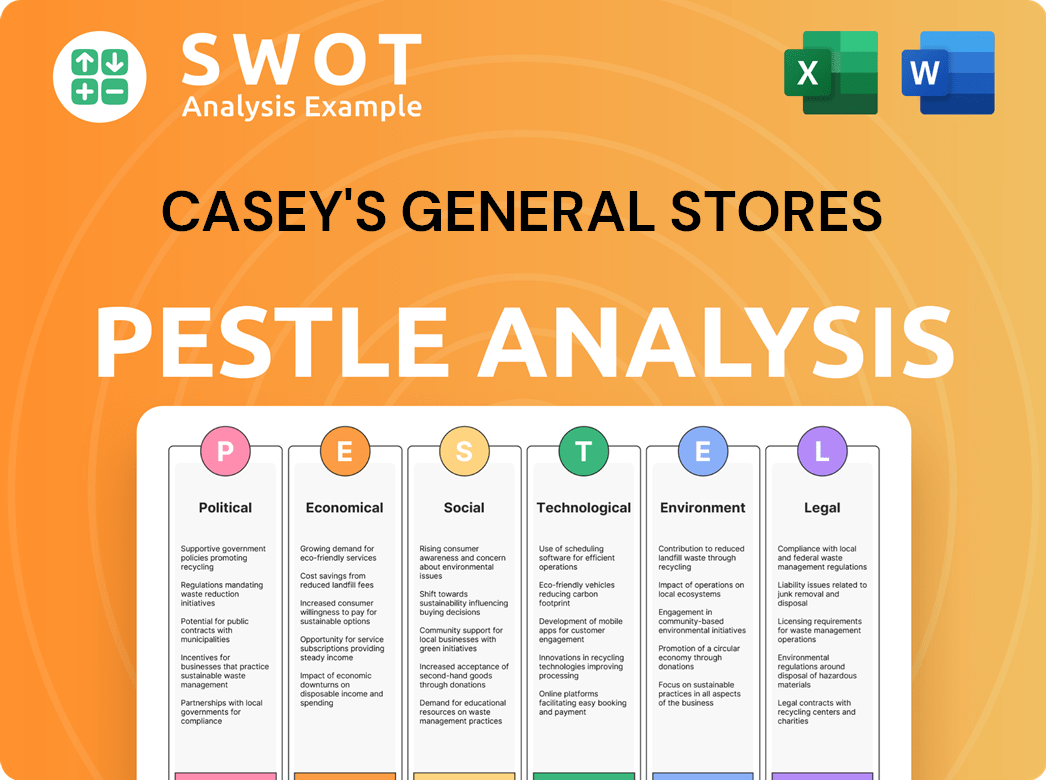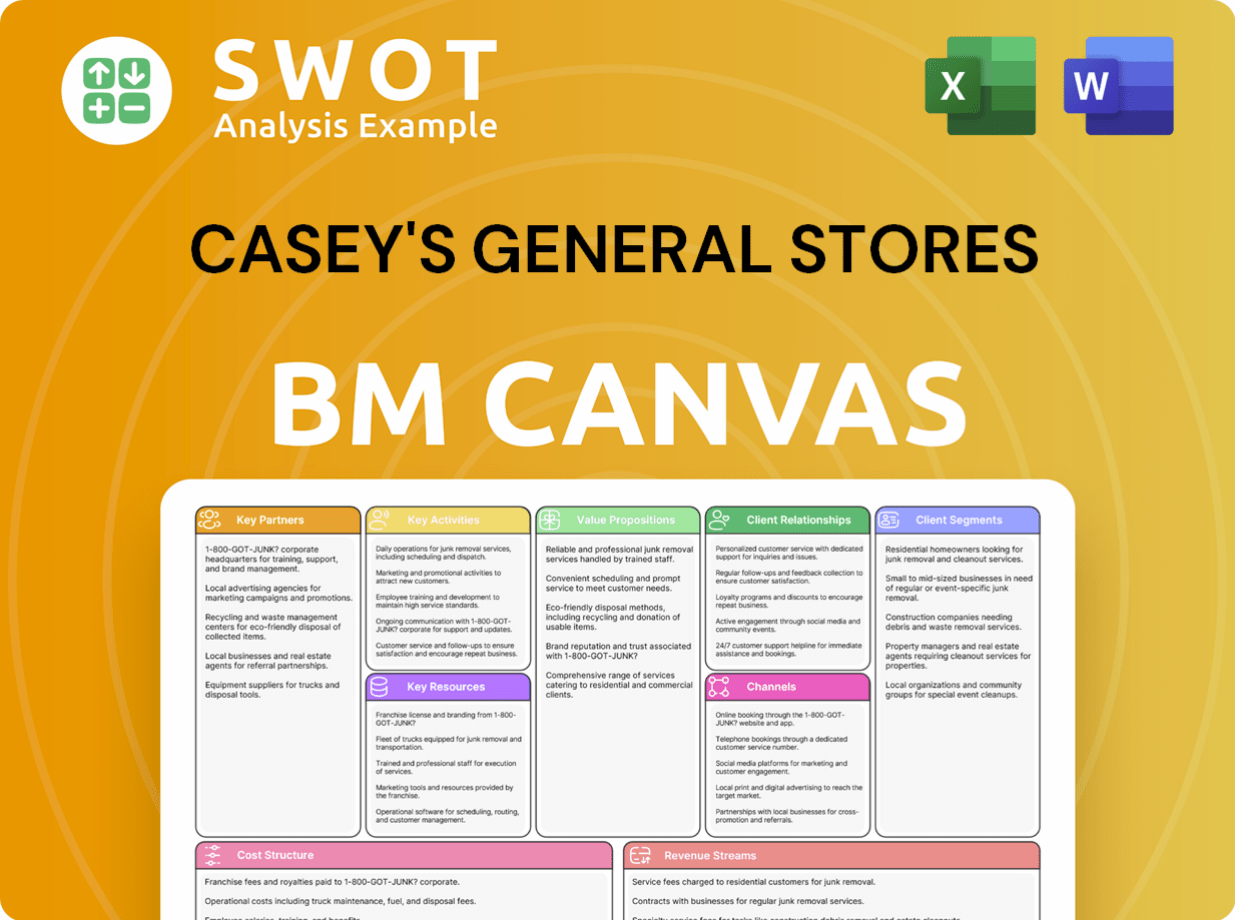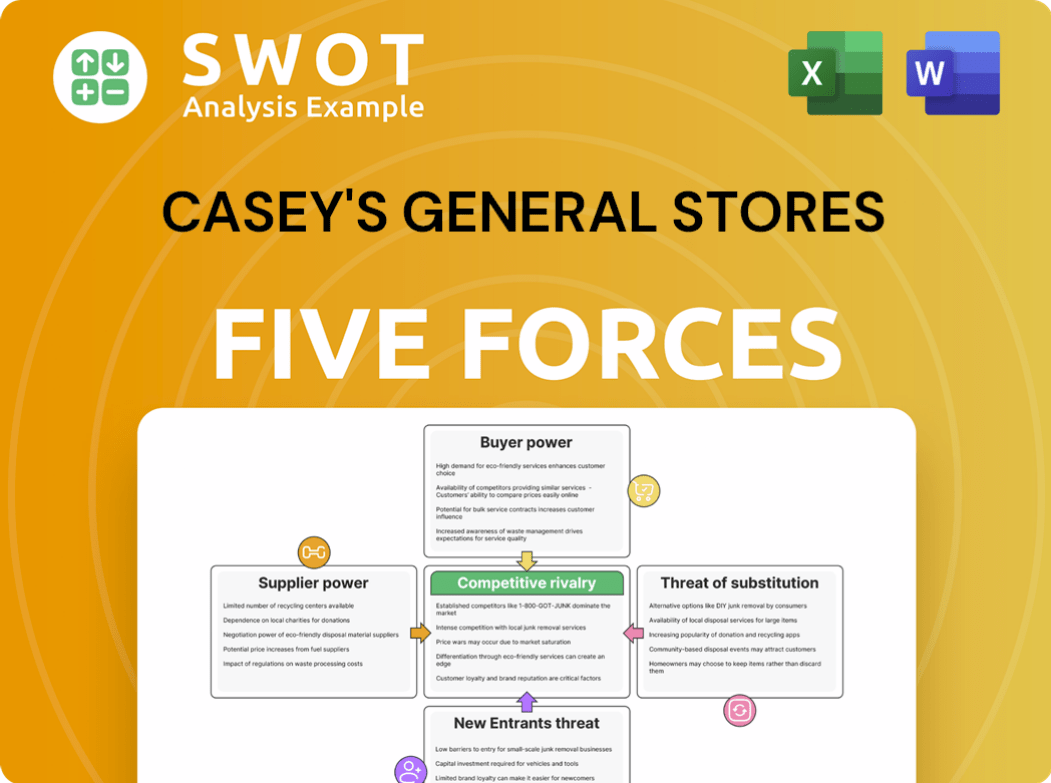Casey's General Stores Bundle
Can Casey's General Stores Maintain Its Competitive Edge?
The convenience store industry is undergoing a significant transformation, driven by changing consumer habits and technological advancements. Casey's General Stores SWOT Analysis highlights its position as a key player, especially in the Midwest and Southern regions. Founded in 1968, Casey's has grown from serving rural communities to becoming a major force in the retail competition landscape.

This market analysis delves into the competitive landscape of Casey's General Stores, examining its primary rivals and strategic advantages. Understanding Casey's General Stores's expansion strategy and geographic footprint is crucial for assessing its future financial performance. We'll explore how Casey's General Stores competes in the market and what differentiates it from competitors like Circle K and 7-Eleven within the convenience store industry.
Where Does Casey's General Stores’ Stand in the Current Market?
Casey's General Stores maintains a strong market position within the convenience store industry, particularly in the Midwestern and Southern United States. As of April 30, 2024, the company operated 2,658 stores across 16 states, making it the third-largest convenience store chain in the U.S. by store count. This strategic geographic presence allows it to serve as a local hub, especially in smaller communities.
The company's core operations revolve around fuel sales, groceries, and prepared food offerings. A key differentiator is its focus on made-from-scratch pizza, donuts, and sub sandwiches, which significantly contributes to inside sales. Furthermore, Casey's has invested in digital transformation to enhance the customer experience through its app and loyalty programs. For the fiscal year ended April 30, 2024, the company reported total revenue of $15.1 billion.
This financial scale and strategic presence enable Casey's to compete effectively against larger national chains and smaller independent operators. A detailed market analysis reveals that while specific market share figures are not always publicly disclosed, Casey's has a solid market position, as evidenced by its consistent revenue growth and strong presence in its core markets. The competitive landscape of Casey's General Stores is shaped by its ability to offer a diverse range of products and services, catering to the needs of its customer base.
Casey's is the third-largest convenience store chain in the U.S. by store count. The company strategically targets rural and suburban markets, where it often holds a dominant position. This geographic focus helps it compete effectively against both larger and smaller competitors.
The company's primary offerings include fuel, groceries, and prepared foods. The made-from-scratch pizza, donuts, and sub sandwiches are significant differentiators. These offerings drive inside sales and contribute to customer loyalty.
For the fiscal year ended April 30, 2024, Casey's reported total revenue of $15.1 billion. This financial strength supports its competitive positioning. The company's consistent revenue growth underscores its solid market presence in the convenience store industry.
Casey's is investing in digital transformation to enhance customer experience. This includes improvements to its app and loyalty programs. These initiatives help the company maintain a competitive edge in the retail competition.
Casey's competitive advantages include a strong presence in its core markets and a focus on prepared foods. Its strategic geographic footprint and customer loyalty programs also contribute to its success. These factors enable Casey's to compete effectively within the convenience store industry.
- Strategic geographic presence in rural and suburban markets.
- Strong prepared food offerings, including pizza and donuts.
- Investments in digital transformation and customer loyalty programs.
- Consistent revenue growth and financial performance.
Casey's General Stores SWOT Analysis
- Complete SWOT Breakdown
- Fully Customizable
- Editable in Excel & Word
- Professional Formatting
- Investor-Ready Format

Who Are the Main Competitors Challenging Casey's General Stores?
The competitive landscape for Casey's General Stores is multifaceted, encompassing a wide array of rivals from various segments of the retail competition. Understanding these competitors and their strategies is crucial for conducting a thorough market analysis and assessing Casey's General Stores' position within the convenience store industry. This analysis helps in evaluating Casey's General Stores' competitive advantages and potential challenges.
Casey's competitors range from large national chains to smaller, local operators. The convenience store industry is highly competitive, with significant players vying for market share. This environment necessitates a detailed examination of each competitor's strengths, weaknesses, and strategic initiatives.
Casey's General Stores faces direct competition from major convenience store chains. 7-Eleven, a prominent player, operates a vast network of stores across the United States. Alimentation Couche-Tard, operating as Circle K and other brands, also poses a significant threat. These chains often benefit from economies of scale in purchasing and marketing. For more details, consider reading the Brief History of Casey's General Stores.
7-Eleven is a major competitor, with a significant presence across the U.S. and a similar range of products. The company's vast network and brand recognition make it a formidable rival.
Supermarkets and hypermarkets, such as Walmart and Hy-Vee, compete in the grocery and prepared food segments. These retailers often have greater purchasing power and a wider selection.
Local and independent convenience stores can pose a challenge due to their deep local ties and personalized service. These stores often have strong community connections.
Mergers and acquisitions, such as 7-Eleven's acquisition of Speedway, consolidate market power. This consolidation can shift the competitive dynamics within the industry.
New entrants focusing on digital-first models or specialized product niches could emerge as disruptors. These companies could change the competitive landscape.
The competitive landscape is dynamic, with constant changes in strategies and market positions. Continuous monitoring and analysis are essential for success.
Indirect competition comes from supermarkets, hypermarkets, fast-food restaurants, and quick-service establishments. These entities compete for the same consumer dollars, particularly in the grocery and prepared food sectors. The competitive environment is also shaped by mergers and acquisitions, which consolidate market power. For example, 7-Eleven's acquisition of Speedway significantly altered the competitive dynamics. The emergence of new entrants, focusing on digital-first models or specialized product niches, could also disrupt the market. The convenience store industry is constantly evolving, requiring Casey's General Stores to adapt and innovate to maintain its position.
Understanding the strategies of key competitors is crucial for Casey's General Stores. This includes analyzing their product offerings, pricing strategies, and expansion plans. Casey's General Stores must continually assess its competitive position to maintain and enhance its market share.
- 7-Eleven: Focuses on a wide product range, extensive store network, and loyalty programs. In 2024, 7-Eleven's revenue reached approximately $85 billion.
- Circle K: Emphasizes aggressive expansion, diverse product offerings, and strategic acquisitions. Circle K's revenue in 2024 was around $65 billion.
- Walmart: Leverages its vast purchasing power and wide selection of goods. Walmart's 2024 revenue was over $600 billion.
- Hy-Vee: Focuses on high-quality products, customer service, and community engagement. Hy-Vee's annual revenue is approximately $13 billion.
Casey's General Stores PESTLE Analysis
- Covers All 6 PESTLE Categories
- No Research Needed – Save Hours of Work
- Built by Experts, Trusted by Consultants
- Instant Download, Ready to Use
- 100% Editable, Fully Customizable

What Gives Casey's General Stores a Competitive Edge Over Its Rivals?
Understanding the competitive landscape of Casey's General Stores involves assessing its key strengths and how it differentiates itself within the convenience store industry. Casey's General Stores has cultivated a strong market position by focusing on specific strategic advantages. These advantages have allowed Casey's to maintain a competitive edge and achieve consistent financial performance.
Casey's General Stores operates with a unique business model, focusing on small towns and rural communities. This strategy allows it to establish a strong local presence. This localized approach is complemented by its food program, particularly its made-from-scratch pizza. This food offering is a significant draw for customers. The company's operational strategies and customer experience make these advantages sustainable and challenging for competitors to replicate.
The company's commitment to digital transformation and customer engagement further strengthens its position. By examining these elements, we can better understand how Casey's General Stores navigates the retail competition and maintains its market share.
Casey's General Stores primarily operates in small towns and rural communities, giving it a significant advantage over competitors. This strategic choice allows Casey's to establish strong community ties and customer loyalty. The company's localized approach is key to its success in the convenience store industry.
The company's made-from-scratch pizza is a major draw for customers, driving inside sales. This unique offering differentiates Casey's from many competitors. The prepared food program is a key element of its competitive strategy.
Casey's benefits from strong brand equity and customer loyalty built over decades. Consistent offerings and community involvement create familiarity and trust. This long-standing reputation supports its market position.
Casey's boasts an efficient distribution network tailored to its store footprint. This ensures timely delivery of products. Efficient logistics are critical for maintaining its competitive edge.
Casey's has invested in digital transformation, enhancing its mobile app and loyalty program, Casey's Rewards. As of January 31, 2024, Casey's Rewards had over 8 million members. This digital engagement strengthens customer relationships and provides valuable data for personalized marketing.
- Casey's Rewards program drives customer loyalty and provides valuable data.
- The mobile app enhances the customer experience and offers convenient services.
- Digital initiatives support personalized marketing efforts.
- These efforts contribute to increased customer engagement and sales.
Casey's General Stores Business Model Canvas
- Complete 9-Block Business Model Canvas
- Effortlessly Communicate Your Business Strategy
- Investor-Ready BMC Format
- 100% Editable and Customizable
- Clear and Structured Layout

What Industry Trends Are Reshaping Casey's General Stores’s Competitive Landscape?
The convenience store industry is a dynamic sector, and understanding the competitive landscape is crucial for assessing the performance of Casey's General Stores. This includes a deep dive into Casey's competitors, market dynamics, and strategic positioning. This analysis provides insights into the current status and future trajectory of the company, considering market trends, challenges, and growth opportunities.
Casey's General Stores faces a complex market environment. The company must constantly adapt to evolving consumer preferences and technological advancements. The company's strategic initiatives and financial performance are key indicators of its ability to navigate the industry's challenges and capitalize on emerging opportunities.
The convenience store industry is evolving, driven by technological advancements and changing consumer behavior. Mobile ordering, contactless payments, and loyalty programs are becoming standard. Demand for fresh and prepared foods is rising, pushing stores to expand their offerings. These trends significantly impact the market analysis and strategic decisions of companies like Casey's General Stores.
Casey's General Stores faces several challenges, including fluctuating fuel prices, which can affect profitability. Increased competition from discounters and supermarkets, who are expanding their convenience offerings, also poses a threat. Labor shortages and rising wage costs are additional concerns. These challenges require strategic responses to maintain competitiveness and profitability.
Significant opportunities exist for Casey's General Stores. Continued growth in suburban and exurban areas aligns with its strategy. Expansion through acquisitions and leveraging data from its loyalty program for personalized marketing can drive sales. Diversification into electric vehicle charging stations presents a long-term growth avenue. These opportunities support the company's expansion strategy.
Casey's General Stores focuses on prepared foods, digital engagement, and a community-centric model. This strategy helps the company remain resilient and capitalize on industry dynamics. This approach is detailed in Revenue Streams & Business Model of Casey's General Stores, which provides a deeper understanding of the company's operations.
Casey's General Stores is adapting to industry trends and facing challenges. The company's focus on prepared foods and digital engagement is a key strategy. The company's ability to navigate fluctuating fuel prices and increased competition is crucial for its financial performance. The company's strategic initiatives and financial performance are key indicators of its ability to navigate the industry's challenges and capitalize on emerging opportunities.
- Technological advancements and changing consumer preferences are reshaping the convenience store industry.
- Fluctuating fuel prices, competition, and labor costs pose challenges.
- Opportunities include expansion, personalized marketing, and diversification.
- Casey's General Stores is well-positioned to capitalize on these trends.
Casey's General Stores Porter's Five Forces Analysis
- Covers All 5 Competitive Forces in Detail
- Structured for Consultants, Students, and Founders
- 100% Editable in Microsoft Word & Excel
- Instant Digital Download – Use Immediately
- Compatible with Mac & PC – Fully Unlocked

Related Blogs
- What are Mission Vision & Core Values of Casey's General Stores Company?
- What is Growth Strategy and Future Prospects of Casey's General Stores Company?
- How Does Casey's General Stores Company Work?
- What is Sales and Marketing Strategy of Casey's General Stores Company?
- What is Brief History of Casey's General Stores Company?
- Who Owns Casey's General Stores Company?
- What is Customer Demographics and Target Market of Casey's General Stores Company?
Disclaimer
All information, articles, and product details provided on this website are for general informational and educational purposes only. We do not claim any ownership over, nor do we intend to infringe upon, any trademarks, copyrights, logos, brand names, or other intellectual property mentioned or depicted on this site. Such intellectual property remains the property of its respective owners, and any references here are made solely for identification or informational purposes, without implying any affiliation, endorsement, or partnership.
We make no representations or warranties, express or implied, regarding the accuracy, completeness, or suitability of any content or products presented. Nothing on this website should be construed as legal, tax, investment, financial, medical, or other professional advice. In addition, no part of this site—including articles or product references—constitutes a solicitation, recommendation, endorsement, advertisement, or offer to buy or sell any securities, franchises, or other financial instruments, particularly in jurisdictions where such activity would be unlawful.
All content is of a general nature and may not address the specific circumstances of any individual or entity. It is not a substitute for professional advice or services. Any actions you take based on the information provided here are strictly at your own risk. You accept full responsibility for any decisions or outcomes arising from your use of this website and agree to release us from any liability in connection with your use of, or reliance upon, the content or products found herein.